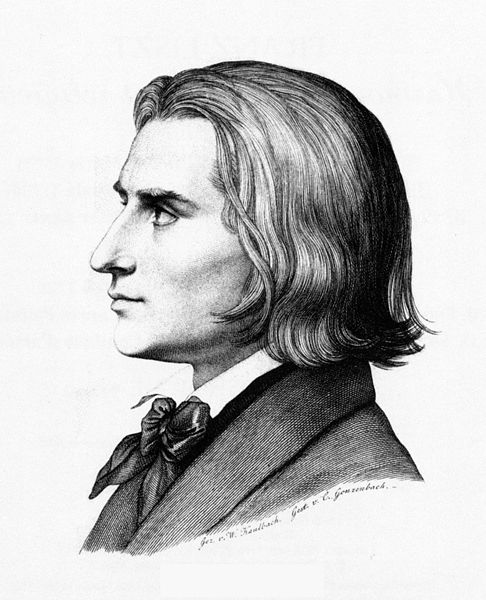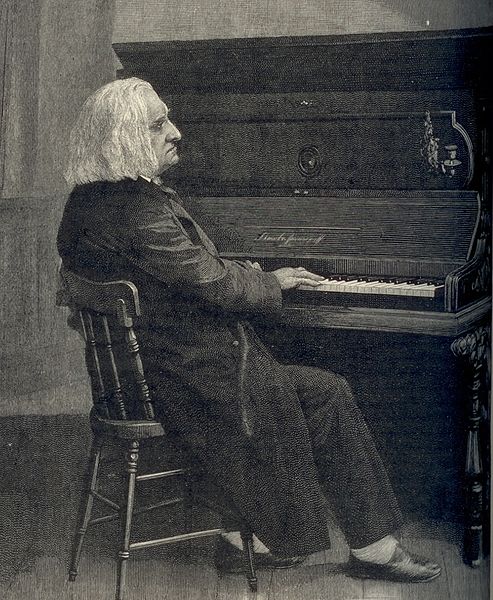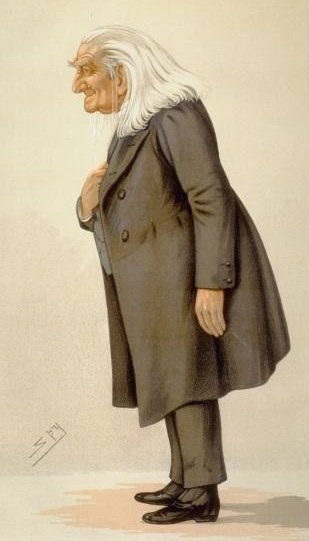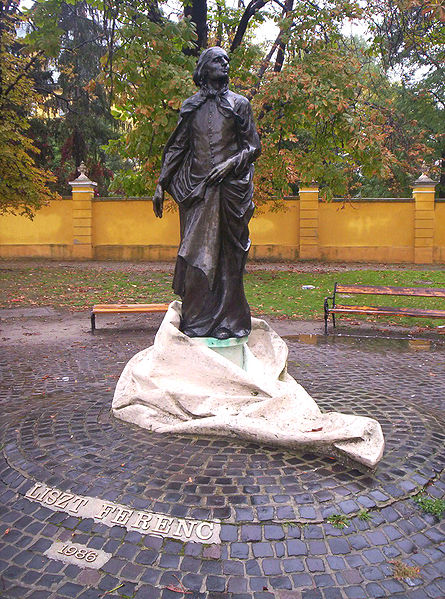<Back to Index>
- Physicist Clinton Joseph Davisson, 1881
- Composer Franz Liszt, 1811
- 2nd President of Mozambique Joaquim Alberto Chissano, 1939
PAGE SPONSOR
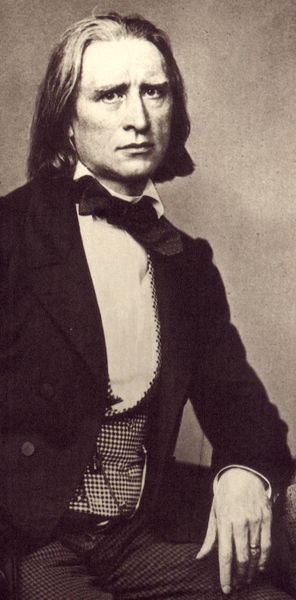
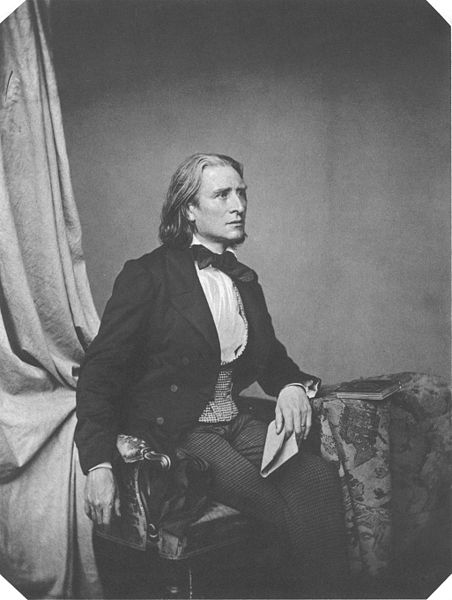
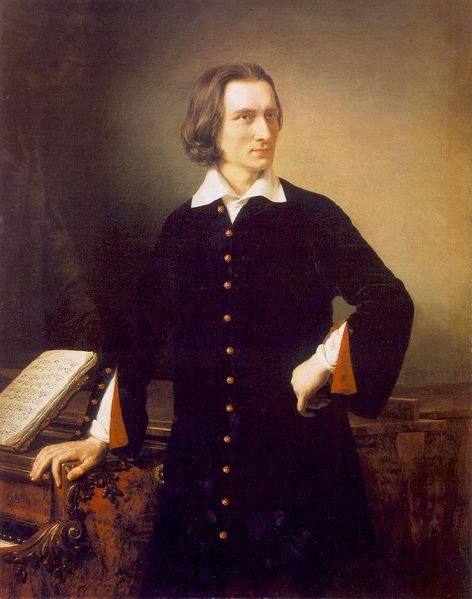
Franz Liszt (Hungarian: Ferencz Liszt, in modern use Ferenc Liszt, from 1859 to 1867 officially Franz Ritter von Liszt) (October 22, 1811 – July 31, 1886) was a Hungarian composer, virtuoso pianist and teacher.
Liszt
became renowned throughout Europe during the 19th century for his great
skill as a performer. He was said by his contemporaries to have been
the most technically advanced pianist of his age and perhaps the
greatest pianist of all time. He
was also an important and influential composer, a notable piano
teacher, a conductor who contributed significantly to the modern
development of the art, and a benefactor to other composers and
performers, notably Richard Wagner, Hector Berlioz, Camille Saint-Saëns, Edvard Grieg and Alexander Borodin. As a composer, Liszt was one of the most prominent representatives of the "Neudeutsche Schule"
("New German School"). He left behind a huge and diverse body of work,
in which he influenced his forward-looking contemporaries and
anticipated some 20th-century ideas and trends. Some of his most
notable contributions were the invention of the symphonic poem, developing the concept of thematic transformation as part of his experiments in musical form and making radical departures in harmony.
The earliest known male ancestor of Franz Liszt is his great-grandfather, Sebastian List, who as one of the thousands of German speaking migrant serfs entered Hungary from Lower Austria in the first half of the 18th century, and died in 1793 in Rajka, Moson County. Liszt's grandfather was an overseer on several Esterházy estates; he could play the piano, violin and organ. The Liszt clan dispersed throughout Austria and Hungary and gradually lost touch with one another. Franz Liszt was born to Marie Anna Lager and Adam Liszt on October 22, 1811, in the village of Raiding (Hungarian: Doborján) in Sopron County. Liszt's father played the piano, violin, cello, and guitar. He had been in the services of Prince Nikolaus II Esterházy and knew Haydn, Hummel and Beethoven personally.
At age six, Franz Liszt began listening attentively to his father's
piano playing as well as to show an interest in both sacred and Romani music.
Adam began teaching him the piano at age seven, and Franz Liszt began
composing in an elementary manner when he was eight. He appeared in
concerts at Sopron and Pozsony in
October and November 1820 at age 9. After the concerts, a group of
wealthy Hungarians offered to finance Franz's musical education
abroad. In Vienna, Liszt received piano lessons from Carl Czerny, who in his own youth had been a student of Beethoven and Hummel. He also received lessons in composition from Antonio Salieri,
who was then music director of the Viennese court. His public debut in
Vienna on December 1, 1822, at a concert at the "Landständischer
Saal," was a great success. He was greeted in Austrian and Hungarian aristocratic circles and also met Beethoven and Schubert. In
spring 1823, when the one year's leave of absence came to an end, Adam
Liszt asked Prince Esterházy in vain for two more years. Adam
Liszt therefore took his leave of the Prince's services. At the end of
April 1823, the family for the last time returned to Hungary. At the end of
May 1823, the family went to Vienna again. Towards the end of 1823 or early 1824 Liszt's first published composition appeared in print, a Variation on a Waltz by Diabelli (now S. 147), which was Variation 24 in Part II of Vaterländischer Künstlerverein.
This anthology, commissioned by Diabelli, included 50 variations on his
waltz by 50 different composers (Part II), Part I being taken up by
Beethoven's 33 variations on the same theme, which are now better known
as the Diabelli Variations, Op. 120. After
his father's death Liszt returned to Paris; for the next five years he
was to live with his mother in a small apartment. He gave up touring.
To earn money, Liszt gave lessons in piano playing and composition,
often from early morning until late at night. His students were
scattered across the city and he often had to cross long distances.
Because of this, Liszt kept uncertain hours and also took up smoking
and drinking — all habits he would continue throughout his life. The following year he fell in love with one of his pupils, Caroline de Saint-Cricq, the daughter of Charles X's
minister of commerce. However, her father insisted that the affair be
broken off. Liszt again fell ill (there was even an obituary notice of
him printed in a Paris newspaper), and he underwent a long period of
religious doubts and pessimism. He again stated a wish to join the
Church but was dissuaded this time by his mother. He had many
discussions with the Abbé de Lamennais, who acted as his spiritual father, and also with Chrétien Urhan, a German-born violinist who introduced him to the Saint-Simonists. Urhan also wrote music that was anti-classical and highly subjective, with titles such as Elle et moi, La Salvation angélique and Les Regrets,
and may have whetted the young Liszt's taste for musical romanticism.
Equally important for Liszt was Urhan's earnest championship of
Schubert, which may have stimulated his own lifelong devotion to that
composer's music. During
this period Liszt read widely to overcome his lack of a general
education, and he soon came into contact with many of the leading
authors and artists of his day, including Victor Hugo, Lamartine and Heinrich Heine.
He composed practically nothing in these years. Nevertheless, the July
Revolution of 1830 inspired him to sketch a Revolutionary Symphony
based on the events of the "three glorious days," and he took a greater
interest in events surrounding him. He met Hector Berlioz on December 4, 1830, the day before the premiere of the Symphonie fantastique.
Berlioz's music made a strong impression on Liszt, especially later
when he was writing for orchestra. He also inherited from Berlioz the
diabolic quality of many of his works. After attending an April 20, 1832 concert for charity, for the victims of a Parisian cholera epidemic, by Niccolò Paganini, Liszt
became determined to become as great a virtuoso on the piano as
Paganini was on the violin. Paris in the 1830s had become the nexus for
pianistic activities, with dozens of pianists dedicated to perfection
at the keyboard. Some, such as Sigismond Thalberg and Alexander Dreyschock,
focused on specific aspects of technique (e.g. the "three-hand effect"
and octaves, respectively). While it was called the "flying trapeze"
school of piano playing, this generation also solved some of the most
intractable problems of piano technique, raising the general level of
performance to previously unimagined heights. Liszt's strength and
ability to stand out in this company was in mastering all the aspects
of piano technique cultivated singly and assiduously by his rivals. In 1833 he made transcriptions of several works by Berlioz, including the Symphonie fantastique. His chief motive in doing so, especially with the Symphonie,
was to help the poverty-stricken Berlioz, whose symphony remained
unknown and unpublished. Liszt bore the expense of publishing the
transcription himself and played it many times to help popularise the
original score. He was also forming a friendship with a third composer who influenced him, Frédéric Chopin; under his influence Liszt's poetic and romantic side began to develop.
In 1833, Liszt began his relationship with the Countess Marie d'Agoult. In addition to this, at the end of April 1834 he made the acquaintance of Felicité de Lamennais.
Under the influence of both, Liszt's creative output exploded. In 1834
Liszt debuted as a mature and original composer with his piano
compositions Harmonies poetiques et religieuses and the set of three Apparitions. These were all poetic works which contrasted strongly with the fantasies he had written earlier. In
1835 the countess left her husband and family to join Liszt in Geneva;
their daughter Blandine was born there on December 18. Liszt taught at
the newly founded Geneva Conservatory, wrote a manual of piano
technique (later lost) and contributed essays for the Paris Revue et gazette musicale. In these essays, he argued for the raising of the artist from the status of a servant to a respected member of the community. For the next four years Liszt and the countess lived together, mainly in Switzerland and Italy, where their daughter, Cosima, was born in Como,
with occasional visits to Paris. On May 9, 1839 Liszt and the
countess's only son, Daniel, was born, but that autumn relations
between them became strained. Liszt heard that plans for a Beethoven
monument in Bonn were in danger of collapse for lack of funds, and
pledged his support. Doing so meant returning to the life of a touring
virtuoso. The countess returned to Paris with the children while Liszt
gave six concerts in Vienna then toured Hungary. For the next eight years Liszt continued to tour Europe; spending holidays with the countess and their children on the island of Nonnenwerth on
the Rhine in summers 1841 and 1843. In spring 1844 the couple finally
separated. This was Liszt's most brilliant period as a concert pianist.
Honours were showered on him and he was adulated everywhere he went. Since
Liszt often appeared three or four times a week in concert, it could be
safe to assume that he appeared in public well over a thousand times
during this eight-year period. Moreover, his great fame as a pianist,
which he would continue to enjoy long after he had officially retired
from the concert stage, was based mainly on his accomplishments during
this time. After 1842 "Lisztomania"
swept across Europe. The reception Liszt enjoyed as a result can only
be described as hysterical. Women fought over his silk handkerchiefs
and velvet gloves, which they ripped to shreds as souvenirs. Helping
fuel this atmosphere was the artist's mesmeric personality and stage
presence. Many witnesses later testified that Liszt's playing raised
the mood of audiences to a level of mystical ecstasy. Adding
to his reputation was the fact that Liszt gave away much of his
proceeds to charity and humanitarian causes. In fact, Liszt had made so
much money by his mid-forties that virtually all his performing fees
after 1857 went to charity. While his work for the Beethoven monument
and the Hungarian National School of Music are well known, he also gave
generously to the building fund of Cologne Cathedral, the establishment
of a Gymnasium at
Dortmund, and the construction of the Leopold Church in Pest. There
were also private donations to hospitals, schools and charitable
organizations such as the Leipzig Musicians Pension Fund. When he found
out about the Great Fire of Hamburg, which raged for three weeks during
May 1842 and destroyed much of the city, he gave concerts in aid of the
thousands of homeless there.
In February 1847, Liszt played in Kiev. There he met the Princess Carolyne zu Sayn-Wittgenstein,
who dominated most of the rest of his life. She persuaded him to
concentrate on composition, which meant giving up his career as a
travelling virtuoso. After a tour of the Balkans, Turkey and Russia
that summer, Liszt gave his final concert for pay at Elisavetgrad in
September. He spent the winter with the princess at her estate in
Woronince. By
retiring from the concert platform at 35, while still at the height of
his powers, Liszt succeeded in keeping the legend of his playing
untarnished. The following year, Liszt took up a long-standing invitation of Grand Duchess Maria Pavlovna of Russia to settle at Weimar, where he had been appointed Kapellmeister Extraordinaire in
1842, remaining there until 1861. During this period he acted as
conductor at court concerts and on special occasions at the theatre. He
gave lessons to a number of pianists, including the great virtuoso Hans von Bülow, who married Liszt's daughter Cosima in 1857 (years after she would marry Richard Wagner). He also wrote articles championing Berlioz and
Wagner. Finally, Liszt had ample time to compose and during the next 12
years revised or produced those orchestral and choral pieces upon which
his reputation as a composer mainly rests. His efforts on behalf of
Wagner, who was then an exile in Switzerland, culminated in the first
performance of Lohengrin in 1850. Princess
Carolyne lived with Liszt during his years in Weimar. She eventually
wished to marry Liszt, but since she had been previously married and
her husband, Russian military officer Prince Nikolaus zu
Sayn-Wittgenstein-Ludwigsburg (1812–1864), was still alive, she had to
convince the Roman Catholic authorities that her marriage to him had
been invalid. After huge efforts and a monstrously intricate process,
she was temporarily successful (September 1860). It was planned that
the couple would marry in Rome, on October 22, 1861, Liszt's 50th
birthday. Liszt having arrived in Rome on October 21, 1861, the
Princess nevertheless declined, by the late evening, to marry him. It
appears that both her husband and the Czar of Russia had managed to
quash permission for the marriage at the Vatican. The Russian
government also impounded her several estates in the Polish Ukraine,
which made her later marriage to anybody unfeasible. The
1860s were a period of severe catastrophes of Liszt's private life. On
December 13, 1859, he had lost his son Daniel, and on September 11,
1862, his daughter Blandine also died. In letters to friends Liszt
afterwards announced that he would retreat to a solitary living. He
found it at the monastery Madonna del Rosario, just outside Rome,
where on June 20, 1863, he took up quarters in a small, Spartan
apartment. He had on June 23, 1857, already joined a Franciscan order. On April 25, 1865, he received the tonsure at the hands of Cardinal Hohenlohe. Following this he was sometimes called the Abbé Liszt. He received the four minor orders on July 31, 1865, porter, lector, exorcist, and acolyte. On 14th August 1879 he was made an honorary canon of Albano. The
title 'Abbé', the French equivalent of 'Father', is a courtesy
title reminiscent of the Eighteenth Century, when it was often given to
men in minor orders; Liszt was never a priest. (Abbé can also mean abbot, but that definition does not apply here at all.) At some occasions, Liszt took part in Rome's musical life. On March 26, 1863, at a concert at the Palazzo Altieri,
he directed a programme of sacred music. The "Seligkeiten" of his
"Christus-Oratorio" and his "Cantico del Sol di Francesco d'Assisi", as
well as Haydn's "Die Schöpfung" and works by J.S. Bach, Beethoven, Jornelli, Mendelssohn and
Palestrina were performed. On January 4, 1866, Liszt directed the
"Stabat mater" of his "Christus-Oratorio", and on February 26, 1866,
his "Dante Symphony".
There were several further occasions of similar kind, but in comparison
with the duration of Liszt's stay in Rome, they were exceptions.
Bódog Pichler, who visited Liszt in 1864 and asked him for his
future plans, had the impression that Rome's musical life was not
satisfying for Liszt.
Liszt
was invited back to Weimar in 1869 to give master classes in piano
playing. Two years later he was asked to do the same in Budapest at the
Hungarian Music Academy.
From then until the end of his life he made regular journeys between
Rome, Weimar and Budapest, continuing what he called his "vie
trifurquée" or threefold existence. It is estimated that Liszt
travelled at least 4000 miles a year during this period in his life — an
exceptional figure given his advancing age and the rigours of road and
rail in the 1870s. On
July 2, 1881, Liszt had fallen down the stairs of the Hotel in Weimar.
Though friends and colleagues had noted swelling in Liszt's feet and
legs when he had arrived in Weimar the previous month, Liszt had up to
this point been in reasonably good health, and his body retained the
slimness and suppleness of earlier years. The accident, which
immobilised him for eight weeks, changed this. A number of ailments
manifested — dropsy, asthma, insomnia, a cataract of
the left eye and chronic heart disease. The last-mentioned eventually
contributed to Liszt's death. He became increasingly plagued with
feelings of desolation, despair and death — feelings which he expressed
in his works from this period. As he told Lina Ramann, "I carry a deep sadness of the heart which must now and then break out in sound." He died in Bayreuth, Germany, on July 31, 1886, at age 74, officially as a result of pneumonia which he may have contracted during the Bayreuth Festival hosted by his daughter Cosima. Questions have been posed as to whether medical malpractice played a direct part in Liszt's demise. Composer Camille Saint-Saëns, an old friend, whom Liszt had once called "the greatest organist in the world" dedicated his Symphony No. 3 "Organ Symphony" to Liszt; it had premiered in London only a few weeks before his death.
